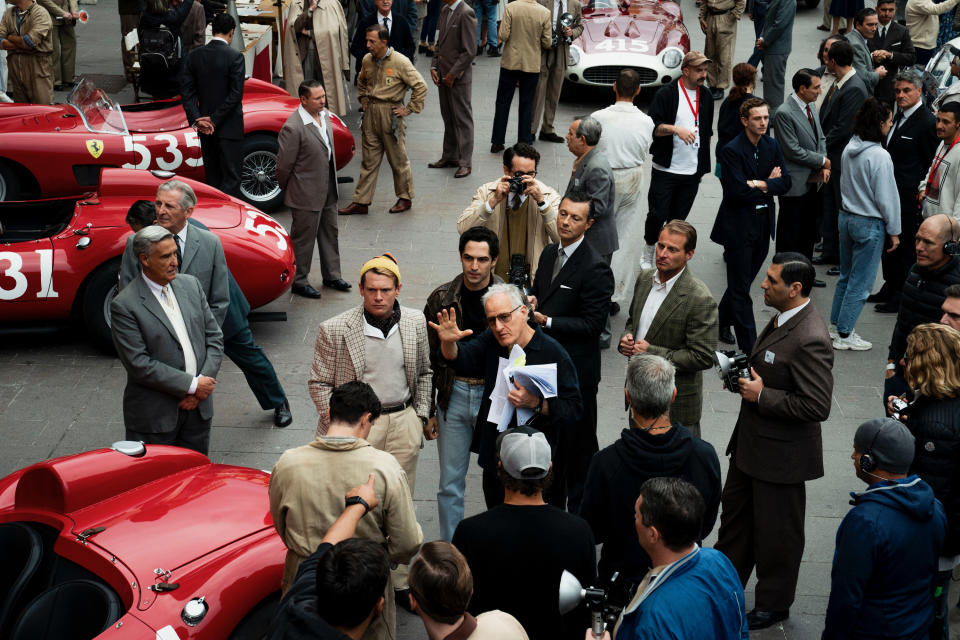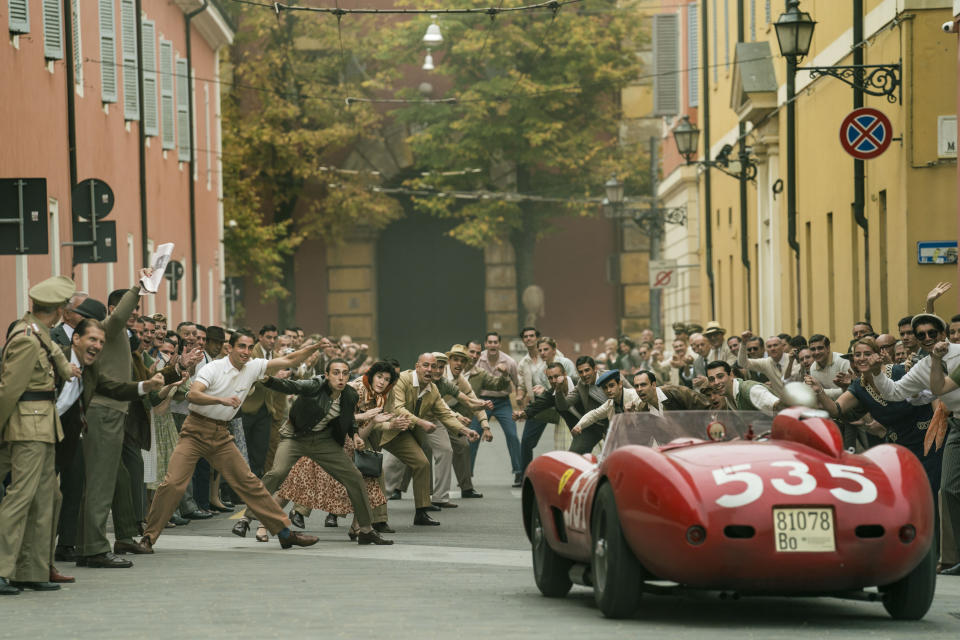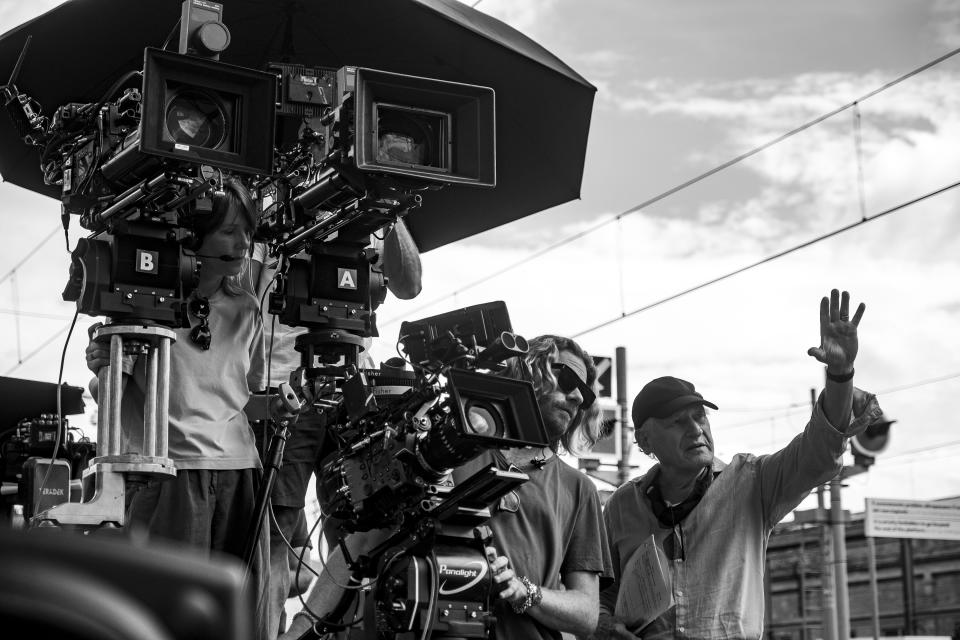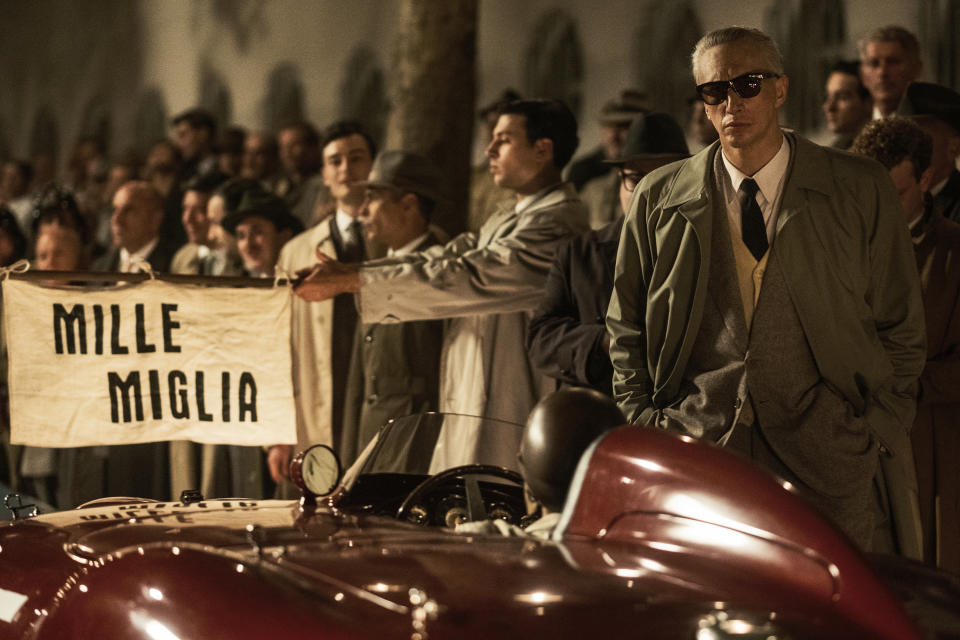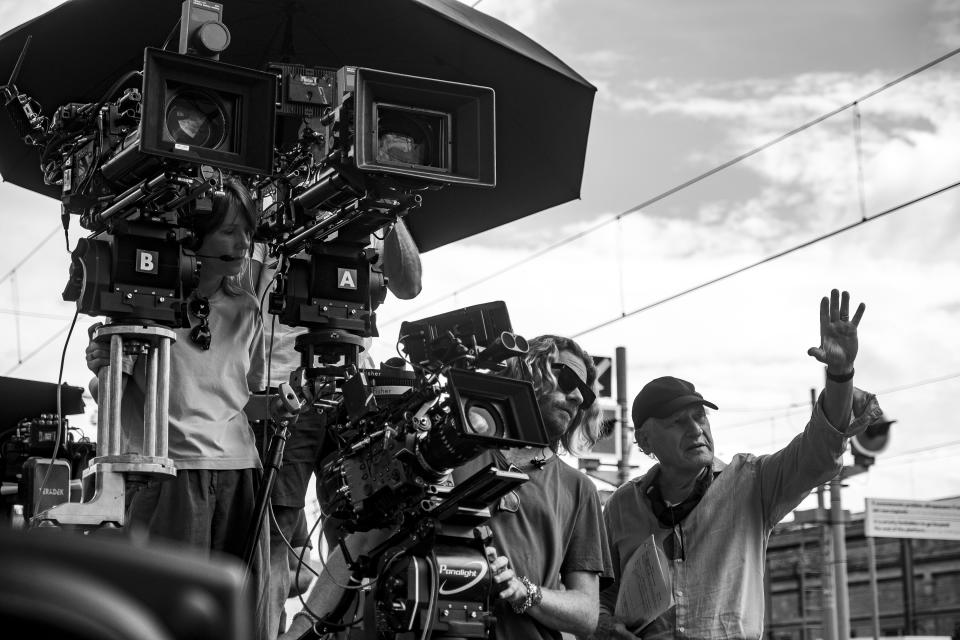How Michael Mann filmed the incredible racing scenes in 'Ferrari'
- Oops!Something went wrong.Please try again later.
- Oops!Something went wrong.Please try again later.
- Oops!Something went wrong.Please try again later.
- - -
Correction: A previous version of this article incorrectly said that the Mille Miglia is 1,000 kilometers. It is roughly 1,000 miles. The article has been corrected.
- - -
There's a spectacular moment in the last third of Michael Mann's "Ferrari" when the dangerous, two-day, roughly 1,000-mile test of endurance called the Mille Miglia enters Bologna. The year is 1957, and this the first time in the film that the swarm of Ferraris, Maseratis and Alfa Romeos has been bottlenecked into a city. Now, instead of jockeying for place on country roads, where a crash will send a driver careening into a field, they're all trying to squeeze past one another on narrow cobblestone streets, with a canyon of ancient and unforgiving brick walls towering above them.
Then, with one deft movement, the camera lands on a single red Ferrari and the face of its driver, Piero Taruffi, "The Silver Fox," played by Patrick Dempsey, as he bursts into the open air of a piazza filled with blinding sunlight and hundreds of screaming bystanders standing close enough to get a limb ripped off.
The sequence comes just after a more sedate scene, with 59-year-old mogul Enzo Ferrari (Adam Driver) in a cafe, getting a phone call bearing news from the race that could change the fate of his company. The shift to the action in Bologna is meant to give you a jolt.
"If you were writing this in a script, you would write, 'Meanwhile, back at the race . . .,'" says Mann by Zoom from his Los Angeles home. "And meanwhile back at the race I want the world to be going by as fast as possible. So I want very narrow streets with buildings on either side, so that we feel like we're driving very quickly. And then when we enter into the square I want the shock of the big area."
More than that, he wanted to introduce the imagery he'd seen in historical photos of the huge crowds that turned out to watch the Mille Miglia year after year. "Everybody is crowded right to the edge of the road all the time, as if, you know, daring themselves," Mann says. "It's almost like the running of the bulls in Spain or something."
Mann understands the allure of living on the edge of danger, as a director whose obsession with fast cars and big guns comes through in "Heat," "Collateral" and his '80s-defining TV show "Miami Vice." At 80, he drives a Ferrari, and for years he competed in the Ferrari Challenge for amateur racers, although he has spent more time on motorcycles. With both, it's like you're "11 years old and dreamed of flying," he says. "You're not thinking about the mechanics. You're not driving the car. You and the car become one organism."
In "Ferrari," he wanted to bring that sensation to audiences, while also telling the story of how Enzo's illegitimate son, Piero (Giuseppe Festinese), came to take over his father's business, against the vehement wishes of Enzo's wife, Laura (Penélope Cruz), and amid a race that embodies what Enzo calls "our deadly passion, our terrible joy."
Here's how Mann pulled off some of the most visceral racing scenes yet caught on film:
The film business is full of tricks for how to fake driving. You can put people in a car that you shake on a soundstage with a green screen behind them. Or put a road down in postproduction. "It's a cinematic grammar that the audience is very used to, but they also immediately recognize it as not real," says cinematographer Erik Messerschmidt. "And Michael didn't want to do any of that. He wanted the cars on the road. And a lot of it, I think, comes from Michael's understanding of the physics of racecars and how they look and how they behave when they're going around a corner and how the weight shifts when you apply the brake and what the car looks like when you downshift. He wanted to get all that."
The immediate problem is that very few 1957 racecars exist today, and all are too valuable to be subjected to the kind of abuse Mann was going to put them through.
That meant action vehicle supervisor Neil Layton and his team had just 22 weeks to build high-functioning replicas of every Ferrari and Maserati on-screen. For one model, no full-size vintage cars are left in existence, so Layton used a technique he had learned creating the Batmobile for "The Dark Knight Rises": He scanned a toy car and multiplied the measurements by 18. He then sent the body shape to Carrozzeria Campana, a family-owned automotive fabrication shop in Modena, near where Ferrari and Maserati are headquartered.
Layton's team made 11 cars, each outfitted with a modern chassis and safety features like five-point harnesses, roll cages and hydraulic hand brakes that had to be hidden because they didn't exist in 1957.
"The nice thing about working with Michael is that he's a big car fanatic. He's a big petrol head buff, and he's a stickler for attention to detail," Layton says. "So the authenticity, the patina on the car and everything, there was no corners that could be cut. We had to make sure that everything was 100 percent correct to the eye." Their hard work was rewarded, he says, when a bunch of mechanics from car companies came to the set and asked Layton where they had managed to find so many 1957 originals.
But since the replicas didn't have the right engines, Mann also had to retrofit the movie's sound by driving vintage cars through the exact circumstances of the race, re-creating every rev and gear change. One of those cars was a single-seat racing Ferrari from the collection of billionaire Lord Bamford; another was a 1953 Ferrari model named after the Mille Miglia and owned by Pink Floyd drummer Nick Mason. "There's nothing quite like the real sound," Mann says. "Sound designers, sound editors, they can't duplicate it. There's a shriek. It's powerful. It's seductive. It's threatening."
Messerschmidt's biggest headache was figuring out how to film the race from the perspective of the drivers, while the cars were going 140 mph. To do that, he mounted cameras on the cars, using older camera equipment to give the shots a shakier, handheld feel. "There's an obsession in modern filmmaking with the hyper-stabilized camera, which gives a very fluid, almost ghostlike feel with the camera following the cars," Messerschmidt says. "That's not what it's like to be in one of those racecars. The suspensions are stiff. You feel every bump."
Messerschmidt's team also invented a tiny, remote-activated dolly that allowed him to slide the mounted cameras along the back and side of each car from a distance. "You can have a shot looking back at an oncoming car, the car could pass the car and then [the camera] could rotate all the way around and shoot the driver, almost as if there was an operator hanging off the side of the car," Messerschmidt says.
For other shots, the cinematographer placed cameras on the roads to capture the shaking of a single twig as the cars rumbled by, and in tracking cars speeding behind the race. But the best shots came from just putting camera operators in the passenger seats with the precision stunt drivers to see what they brought back - which is particularly terrifying as a controlling cinematographer on a 58-day shoot. "There's constant anxiety," he says, "managing the exposure on the camera and hoping the camera stays on the car, and then just letting the stunt drivers take it on the circuit and hoping they'll get the moments that are so vital to the film."
A devoted amateur racing enthusiast, Dempsey has competed in France's famous 24 Hours of Le Mans race multiple times, finishing fourth in his category in 2013. He did all his own driving on the film, and he was the only actor who could just take off down a country road with a camera operator by his side.
A huge part of the film is these drivers wrestling with their addiction to speed vs. the incredible danger that comes with it. In one scene, Mann shows their race-night ritual of writing a letter to their loved ones in case they die. Dempsey proved incredibly valuable in coaching his fellow cast members about what those moments of introspection would feel like.
As a driver, he was a cinematographer's dream. "He was as capable, if not more capable, than all of our stunt drivers in executing these very precise maneuvers," Messerschmidt says. At the end of every take, Dempsey would come back to look at the footage and give himself notes on how he could give the car a little more shake in one instance or throw a look at the camera in another.
Scenes in Bologna, Ravenna and Rome were actually filmed in downtown Modena, while many others were shot in the nearby countryside on the exact roads where Ferrari does its rigorous testing. "You need to understand that Ferrari and Modena go together; he's like royalty there," says stunt coordinator Robert Nagle. "That name just carries so much weight. It really wasn't that difficult to get what we needed." Location manager Janice Polley just charmed shop owners and worked around the city's busy summer schedule of festivals to book out a few weekends.
From there, it was up to Nagle to prep the roads for any hazards as the cars sped through the middle of Modena at 50 or 60 mph. "I hire drivers who won't hit the 600-year-old buildings," he says, but he did worry the cars might turn up cobblestones that could go flying through the air, or create an unexpected divot. Barricades of hay were the art department's fix to cover up jarring bits of modernity, like unsightly drainage.
More worrying was the task of creating authentic crowds, because Mann doesn't like to use computer-generated images. Those are all real extras from Modena lining the road, dressed in period costumes, with professional stunt people in the row closest to the action. Farther back, you might spot Modena residents who just came out to watch, although Mann did end up using a little digital magic to fill in gaps.
If you watch modern racing, with drivers walking away from burning crashes in their fireproof suits, it's hard to believe that in 1957, racecar drivers didn't wear seat belts. "In fact, they believed it was better to be thrown from the vehicle than it was to be in it when it hit something," Nagle says. "What they didn't want was to be trapped in the car that was on fire." So, to maintain period accuracy while also keeping their drivers safe, Nagle created a five-point safety harness that the drivers would wear under their uniforms.
Every violent, brutal crash in the movie is based on historical newsreel footage, including an early one in which a driver hits a curb and his car gets launched against a wall. To re-create it, a replica car made of aluminum was thrown into a building with a crash dummy inside. And because the stunt team only had two copies of the car, it had to get it right. "At that point in the movie, it was really important to illustrate just how dangerous and fragile this world is for these guys," Nagle says. "Most drivers didn't retire back then. The attrition rate was ridiculous."
During his research, Mann was fascinated by an eyewitness account of that initial crash from Maserati star Jean Behra, who went on to drive in the 1957 Mille Miglia - and died during a race in 1959, when he was thrown from his Porsche into a flagpole.
On this film, though, Mann says, the safety of the actors and stunt drivers was paramount. "I've never had anybody hurt on a movie ever, including 'The Last of the Mohicans,' which was treacherous because we were shooting up on that path on the side of a mountain for, like, two weeks," he says. "I think my biggest injury we ever had was a woman broke her ankle at one point because she fell out of a golf cart."
This film, for Mann, boils down to the power of chasing a high. It's one he experienced during those years of racing in the amateur Ferrari Classic. There was a tricky three-turn sequence on his practice track that he'd attempt 75 times a day, and got right, he thinks, only once. But that one time was pure ecstasy. "And given the imagination of a director," he says, "all I have to do is do it once to get an idea, 'Oh, I can project what it must feel like if you do it right all the time.'"
Related Content
Why these homes in the hottest places don't need AC
Her story fueled anti-trans bills. Now, she's fighting them.
Michael Bennet's family fled the Nazis. Now, he won't give up on Ukraine.
